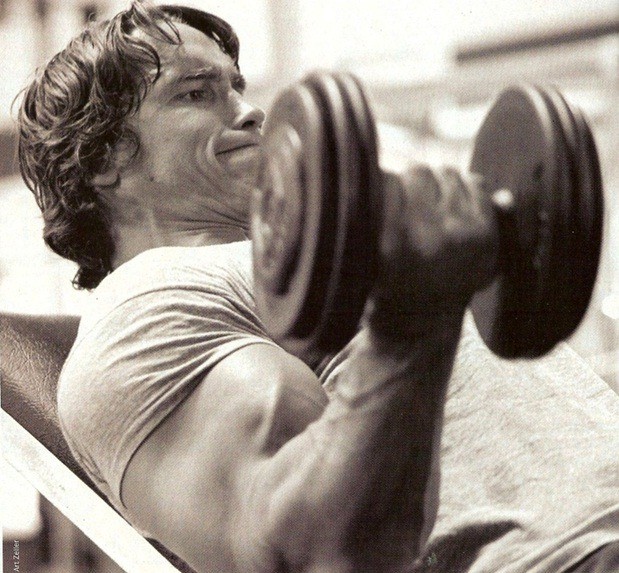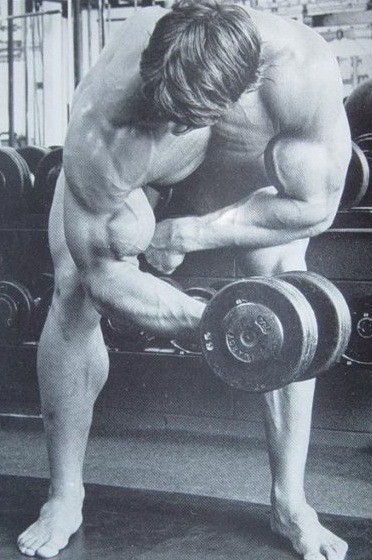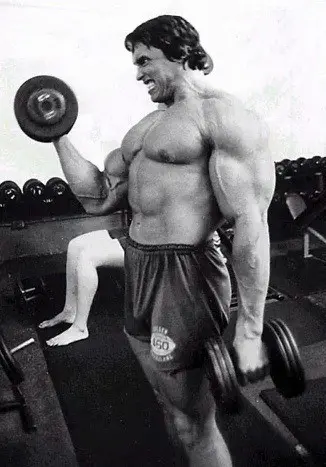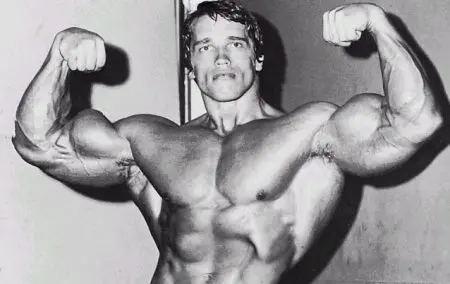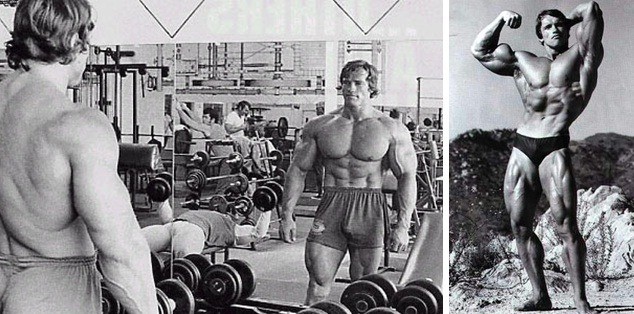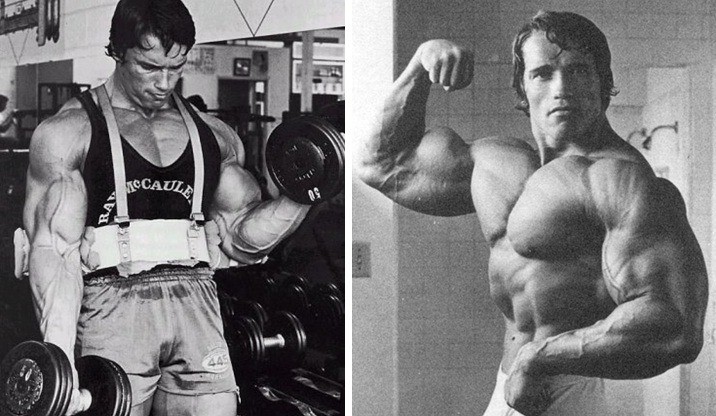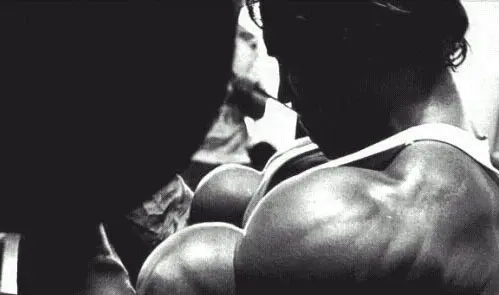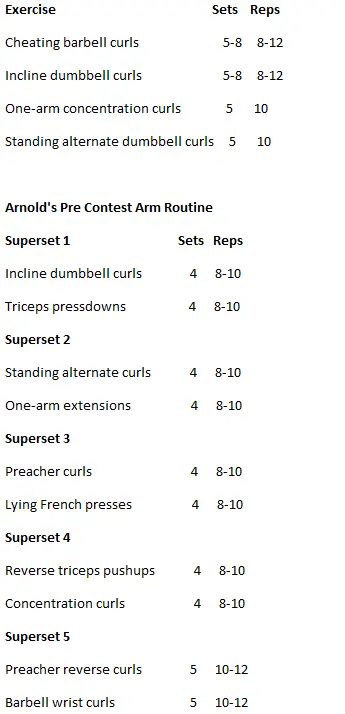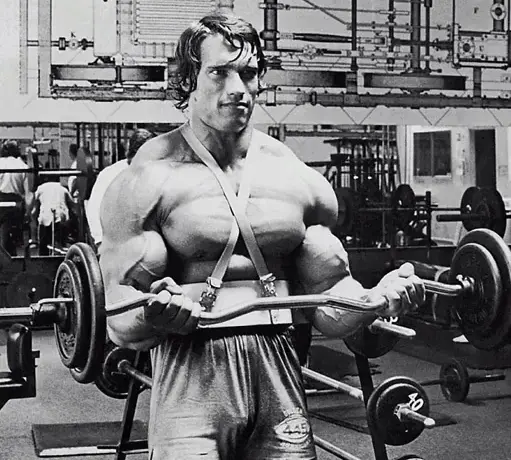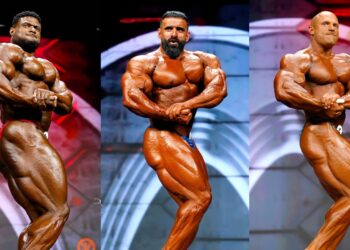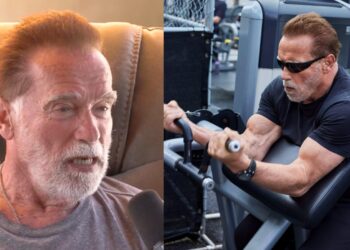Exercise 2: Incline dumbbell curl
“I lie on a 45-degree incline bench. I prefer the low incline because it permits the biceps to fully extend at the bottom of the movement and remain under this tension during the entire movement upward.” One of the rules of muscle kinetics says that the greater the initial tension on the muscle, the greater the number of contracting fibers during flexion.”
“Therefore, when you have a lot of fibers contracting all at once, you are building mass. I strive for full extension and full contraction.”
At this point, his arms engorged with oxygen-carrying blood, Schwarzenegger would move on to the isolation movements.
Exercise 3: One-arm concentration curl
“This one is done in a standing bent-over position using the free arm for support.”
Get Fitter, FasterLevel Up Your Fitness: Join our 💪 strong community in Fitness Volt Newsletter. Get daily inspiration, expert-backed workouts, nutrition tips, the latest in strength sports, and the support you need to reach your goals. Subscribe for free!
Form during this concentration curl movement becomes highly critical. The tendency prevails, even among the most experienced bodybuilders, to draw the elbow in toward the chest during this movement. The elbow must not move from the vertical plane of the curling movement. The upper arm must remain vertical, and the dumbbell must be curled to the shoulder. Although it seems like a restricting uncomfortable movement, it remains the secret to peak biceps development.”
Finally, with his arms screaming for mercy, Schwarzenegger would head back to the dumbbell rack for a final assault with his fourth exercise.
Exercise 4: Standing alternate dumbbell curls
“As the dumbbell is curled, the hand is supinated as though trying to touch the little finger to the outer head of the biceps at the peak of the contraction.”
With this movement, you get that famous little burst of muscle that peaks up the outer biceps head and lends the ultimate touch to any kind of biceps pose. So you must remember to twist the hand as you curl, two motions in one. The biceps come into play quite strongly to supinate your hands, as well as to flex the arms. This little twist gave me separation, brachialis development, and lower biceps thickness.”
That’s Enough
Four exercises, 20-26 sets, 45 minutes a monstrous biceps workout by nearly anyone’s standards. But for Schwarzenegger, it was just enough. “If I did them right, I didn’t need more,” he offers.
“There are supplemental things I’d do between sets like stretching my biceps muscle by extending my arm and drawing it backward. I feel that stretching releases the compression of the blood vessels and lets the blood rush in to perform its functions.”
Precontest Routine
“Three months before a contest, I would change my arm routine completely,” says the Oak. “My goal now was to zoom in on chiseling in all the cuts and shape possible. I’d cut down on my sets and go to a superset style of training and try to get a maximum pump each workout.” During this period, Schwarzenegger would shift into overdrive, training each entire arm in superset fashion with little or no rest between the supersets. Being that he was now working on a six-day double split (two workouts per day, six days per week), he’d be blasting his arms with this grueling routine three times each week. And you thought his mass-building routine was a bear! But there’s more.
“When I was zeroing in for a big contest, I’d stand in front of the mirror between sets for biceps and flex my arms, holding the flex for a minute, maybe two, even three minutes. I’d do that because contest posing is hard. Having muscle is one thing, but having control over it and endurance are two others.”
A word of caution from the big fella, though: “This system has worked very well for me, but it is a severe form of advanced training that is not recommended for beginners.” So just who, besides giant Austrians, can successfully employ either of these gut-wrenching routines?
Do As I Say, Not As I Do
The great Boyer Coe once said, “‘Heavy duty’ is the only way to train if you’re Mike or Ray Mentzer.” Steve Michalik burned through many more partners than he could find to keep up with his “intensity or insanity” approach to training. Now, it could be argued that Arnold Schwarzenegger is at least as, if not more, physiologically gifted than any pro ever. His recuperative powers are almost otherworldly and his threshold for pain legendary. So trying to emulate either of these two workouts may not be advisable, or feasible, for even an experienced bodybuilder. But, gifted or not, Schwarzenegger can also be credited with being history’s hardest thinking bodybuilder. Nothing he ever did throughout his bodybuilding career was accidental or haphazard, which means his programs can serve as tried-and-true templates for your own bodybuilding success, regardless of your experience level or development.
“For beginners, I’d simply advise doing five sets of barbell curls and five sets of dumbbell curls 10 total sets of eight to 12 repetitions,” Schwarzenegger says. “Concentrate on a strict movement, and try to gain some strength. Experiment with different curling arcs until you find the one that puts maximum resistance on your biceps.”
Get Fitter, FasterLevel Up Your Fitness: Join our 💪 strong community in Fitness Volt Newsletter. Get daily inspiration, expert-backed workouts, nutrition tips, the latest in strength sports, and the support you need to reach your goals. Subscribe for free!
After training for a year or so, a bodybuilder is considered to be at the intermediate level, at which point Schwarzenegger advises, “I’d look at your biceps development and determine where you have weak points. Then I’d give you a tailored program to bring these weaker areas of your biceps up to par.
“If you lack biceps fullness,” he continues, “do heavy dumbbell curls. If you lack peak, do everything with dumbbells. Do plenty of concentration curls and dumbbell curls lying back on a high bench, like Reg Park used to do them.” Schwarzenegger says 12 sets total for biceps should serve the intermediate bodybuilder nicely.
Finally, Schwarzenegger reserves his most surprising bit of advice for advanced trainers. “The biggest post-intermediate-level mistake is to burn the biceps out. Biceps are basically a small muscle group, and you can’t do too much for them without overtraining,” instructs the Terminator of training. So, what constitutes overtraining? “I’d say the upper limit for biceps would be 15 sets in a hard workout, but I see all kinds of bodybuilders doing 25 to 30 sets on a regular basis.”
Not that there would be anything wrong with hitting the biceps with 25 to 30 sets per workout if your name happened to be Schwarzenegger.
Hasta La Vista!
Schwarzenegger spilled the beans and gave readers his advice for building massive biceps; now it’s your turn to put his wisdom to use. Put this magazine down, get to the gym and start bombing! Before you do, let the Oak offer you one last bit of wisdom, an axiom regarding muscle growth that spurred him through every workout to ultimate success: “It’s a case of mind over matter. If you’ve got the mind for it, only one thing matters reaching your goal. And you will!”
Arnold’s Off-season Bicep Routine
So Alp Me!
Arnold Schwarzenneger’s five rules for biceps
- Variety Switch around using barbells, dumbbells and cables.
- Isolation Don’t get help from the delts, lower back or other bodyparts when training biceps. Don’t swing the weight (except during chest curls).
- Full range of motion As this implies, move the weight in a controlled but complete fashion, unless you’re using an intensity movement for a shock session.
- Find the groove Locate the natural line of motion for each movement.
- Total concentration Don’t let your mind wander. Always fixate on the movement and the feeling in the muscle.
Using Arnold’s routine
We feel it’s our solemn duty to let you, our astute readers, know that Arnold Schwarzenegger is a one-in-a-million kind of guy, if not a once-in-a-lifetime phenomenon. “No kidding,” you say. “Why are you telling us something we’ve known since we had muscles worth flexing?” By overstating the painfully obvious, we hope to make the point that as a uniquely gifted athlete, Arnold was capable of doing things in a gym that most mere mortals might find overtaxing if not damn near impossible. Even in advanced athletes, symptoms of overtraining, including chronic fatigue and injury, can result from trying to follow Arnold’s workouts to a T or a T3. That being said, we believe that all bodybuilders young and old, novice and pro can benefit by following the principles presented by Arnold in this article.
Because bodybuilding is such an individual activity, it only makes sense that you should tailor every routine to your personal capabilities and goals anyway.
Unless you’re at an advanced level, we advise you not to try to emulate the volume of work Arnold did for biceps.
If you’re a beginner or an intermediate, perform two or three sets per exercise from his offseason routine, and see how it goes. If you’re an advanced competitive bodybuilder, we recommend that you confine yourself to performing three of the five precontest supersets.
In structuring your workload, remember what Arnold considers to be one of the greatest keys to bodybuilding success: Understand your own body.
Author: Shawn Perine
References:
http://www.muscleandfitness.com/
http://www.flexonline.com/
COPYRIGHT 2010 Weider Publications
COPYRIGHT 2010 Gale Group

